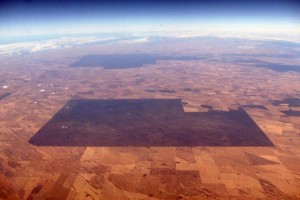I travelled to Adelaide and back to Brisbane by plane last week, and as I flew overhead and looked out at the scenery, I was disturbed to see the amount of natural bushland which had been cleared to make way for farmland. Whilst I saw some large tracts of bushland still remaining, there was a lot more removed than there was remaining.
I know we read that our lifestyle and meat-eating diet is killing our planet, but it is only when we see it for ourselves that we start to comprehend the scale of the problem.
More and more bushland is cleared every week so that we can build our houses, and with a growing population, we might ask what choices we have. But clearing takes place to provide us with food as well. When flying overhead, it is obvious where the straight line of a property boundary delineates the edge of a tract of forest.
Although it is not quite so obvious, you can get a bit of an idea when looking at Google Earth, particularly if you zoom in.
We know that Australia has always had its deserts, but are we contributing to desertification of the rest of the continent through our lifestyle and diet?
Land clearing is on the rise in Australia, and around 6,878 square kilometres are cleared each year, with the majority of this being in Queensland and New South Wales. It is no wonder then, that it is noticeable from the air.
Australia has one of the highest rates of carbon emission in the world, at 5 times the world average per capita rate. Rather than increasing our emissions by clearing forests, we should be increasing our forest coverage. Instead our clearing rate is the fifth highest in the world.
As well as reducing our ability to offset our CO2 emissions, our reduction of forests increases the temperatures on our continent and reduces our rainfall.
One of the greatest problems this clearing causes is the reduction of habitat for vast numbers of species of animals. According to the Wilderness Society, the equivalent of 50 football fields of wildlife habitat, including native trees, is destroyed every hour in this country.
Rainforests are often referred to as the lungs of our planet, because the plants and trees convert CO2 into O2 during photosynthesis, and the majority of the carbon from this process is stored in the tree or plant. However, when the cut trees are burned or rot, the carbon returns to the atmosphere as CO2, and this is the outcome when our forests are cleared to provide more farming land.
As our clearing habits contribute to global warming and an increase in CO2 levels, it also contributes to a reduction in the rate that the remaining trees and plants give off water vapour, thus reducing the amount of water in the atmosphere, but also reducing the cooling effect that this provides, thus exacerbating the global warming problem.
It is time we began making a stand against clearing of our native forests.
It is time we insisted on the replanting of large areas of our native forests.
It is time to understand that we, as individuals, can make a difference with all of our choices, including our food choices. It is time to consider going vegan.
http://whyveg.com/save_the_planet/
http://cncf.com.au/why-offset/
http://treeday.planetark.org/documents/doc-752-ntd12-the-benefits-of-trees.pdf
https://answers.yahoo.com/question/index?qid=20120229204206AA6FNRl
http://www.livescience.com/6429-surprise-plants-contribute-global-warming.html
(Photo details:
Australia from above | Reuters.com
Photographer: David Gray
Location: ADELAIDE, Australia
/ An area of vegetation can be seen amongst drought-affected farmland in South Australia, November 12, 2015.
REUTERS/David Gray)


Leave A Comment